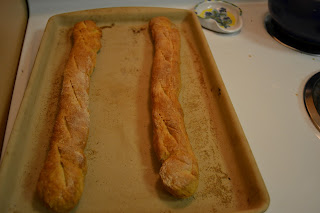So, sometimes things don't work out and other times things do. This week I made two breads, both of which were called french bread but were from different recipes in different books. The first was a failure bread and the second was a redemption bread. I learned just how much of a beginner I am and that following the directions is not always enough but other times that works out just fine. So, I will start with the failure and end with redemption.
The first recipe came from Rosy Levy Beranbaum's The Bread Bible. This book has a ton of recipes of all kinds of different breads with tips from what equipment you need to buy to illustrations of various techniques. I bought this book because I had read a lot of positive reviews from various places and it seemed like this was a perfect book for a beginner.
This recipe called for two starter doughs.
A pate fermentee or scrap dough
and a Poolish
I made these two starters the day before I wanted to have the bread. I ended up putting the doughs in my bedroom for the fermentation stage because the night before I discovered that my kitchen was much too cold, so cold that neither dough was doing what it was supposed to. The second attempt the pate fermentee rose and was left in the refrigerator over night and the poolish was left over night in my overly warm bedroom. As much as it was nice that it was conducive to yeast activity it was not so swell for sleeping. In the morning I was happy to see that everything had come out right so far. I thought I was moving in the right direction.
I combined the two starters and made the dough for the bread.
So I covered the dough and when it had risen I divided it and following the illustrations as best as I could, shaped it into a pre-baguette shape. Then let it rest for ten minutes.
I stumbled through shaping it into the final baguette shape. I suspect that I didn't quite do this right.
So my baguette stretching might have been a bit gung ho, it ended up a little longer than I intended. Also as I was moving it to the baking sheet it got pretty badly degassed, meaning that it was pretty deflated when it went into the oven. It wasn't much of a surprise when this came out of the oven.
It was sort of a bummer to say the least. I really did try to baby this dough. I certainly didn't do a perfect job but I felt a tiny bit betrayed by the bread. I don't blame The Bread Bible but this recipe certainly wasn't as fool proof as I thought it was going to be. It was not a very successful night of baking to say the least.
Now let's move on to the happy ending. This second french bread is from a book I have come to really love, Peter Reinhart's The Bread Baker's Apprentice.
This recipe called for just one starter , a scrap dough or pate fermentee.
I let it rise to about one and half times its original size.
The fact that this worked out was a good sign. The failure bread was starting to cause me to lose faith in my breadsmithing abilities. This tiny victory was a good omen. So I let that chill over-night in the refrigerator and made the dough for the bread the next day.
Then it had to sit and rise and it did just that. It got big and puffy and perfect.
I divided the dough and shaped it into a sort of baguette loaf hybrid. I'm not great at the whole shaping thing yet but appearances aren't everything.
I let that proof for about 45 minutes.
Then all that was left was to pop it into the oven, get some steam action going with some ice cubes and a spray bottle, give it some time and out came a pretty appetizing something.
It turned out delicious, the absolute opposite of a bummer.
I have every intention of trying the first recipe again. I want to make it work. I want every bread I start to work out and for that matter I want most things to work out. Who doesn't? You put so much care into these breads. I had mine in the room with me while I slept. I practically cradled it. So when it doesn't make that jump from tasteless flour to something warm and delightful its not a good time. I had very different experiences with these two doughs, but I got my mojo back in the end. I am ready for the next challenge.





















